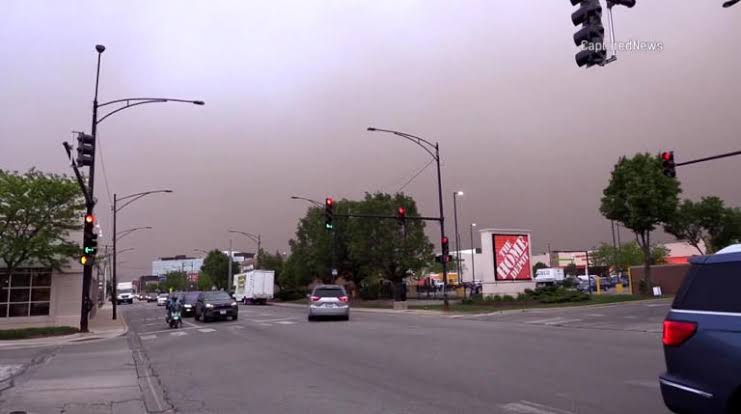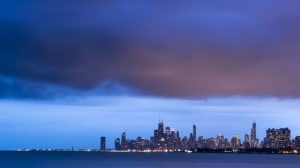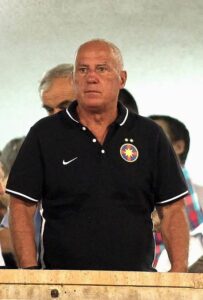
Breaking News: Dust Storm Engulfs Chicago in Unprecedented Phenomenon
In a startling and rare event, Chicago, the city renowned for its towering skyline, vibrant neighborhoods, and bustling urban life, experienced a massive dust storm that blanketed the metropolis earlier today. Witnesses and residents captured breathtaking footage of a swirling, ochre-hued cloud sweeping through the city streets, turning familiar landmarks into surreal silhouettes. Experts are calling this event one of the most unusual weather phenomena in recent history for the region.
The dust storm, which struck unexpectedly in the late afternoon, was characterized by a dense cloud of fine particulate matter descending rapidly upon the city, reducing visibility to near zero in some areas. Streets that were teeming with activity moments before suddenly fell silent as residents scrambled to seek shelter. The storm persisted for several hours, leaving behind a thick layer of dust on vehicles, buildings, and even inside homes.
### Witness Accounts and Immediate Impact
Eyewitnesses described the scene as “something out of the history books,” emphasizing the rarity of such an event in a city more accustomed to snowfalls, thunderstorms, and the occasional tornado. Maria Lopez, a resident of the Near West Side, recounted her experience: “I was walking home when the sky suddenly turned dark, and a wall of dust came rushing toward us. It was terrifying. I’ve never seen anything like this in Chicago.”
Transportation disruptions were widespread. Several flights arriving at O’Hare International Airport were delayed or diverted due to low visibility and safety concerns. Local buses and trains faced delays, and some routes were temporarily suspended. Authorities urged residents to stay indoors, keep windows and doors closed, and avoid unnecessary travel.
### The Science Behind the Storm
Meteorologists and environmental scientists are analyzing the event to understand its origins. Dust storms typically occur in arid or semi-arid regions, often triggered by strong winds that lift loose soil and particulate matter into the air. The Midwest is not usually associated with such phenomena, making this event particularly unusual.
Preliminary reports suggest that the dust storm may have been initiated by a combination of factors, including recent drought conditions across parts of the Midwest and Great Plains, strong wind patterns, and perhaps land disturbance activities. Some experts speculate that the storm could have been exacerbated by distant wildfires or dust storms originating from western states and carried eastward by prevailing winds.
Dr. Samuel Chen, a climatologist at the University of Chicago, explained, “While dust storms are common in desert regions like the Southwest, their occurrence in Chicago is exceedingly rare. This event indicates changing weather patterns and possibly the increasing influence of climate variability. It’s a stark reminder of the interconnectedness of environmental factors across regions.”
### Historical Context
Dust storms have historically been associated with the Great Plains and southwestern United States, with infamous examples like the Dust Bowl of the 1930s. During that era, severe dust storms devastated agriculture and displaced thousands of residents. In contrast, Chicago’s urban landscape has generally been insulated from such phenomena, making today’s event a startling anomaly.
While there have been occasional dust-related events in the city’s distant past, none have matched the scale and intensity of today’s storm. Experts are now questioning whether climate change and land management practices are contributing to the emergence of more such unusual weather events in urban centers like Chicago.
### Environmental and Health Concerns
The dust storm raises immediate health concerns, particularly for vulnerable populations such as children, the elderly, and those with respiratory conditions. Fine particulate matter can exacerbate asthma, bronchitis, and other respiratory issues. City health officials have issued advisories urging residents to wear masks if venturing outside and to seek medical attention if experiencing respiratory distress.
Air quality indices spiked dramatically during the storm, prompting the Chicago Department of Public Health to monitor air pollution levels closely. Hospitals reported an increase in respiratory-related calls and visits. Authorities distributed masks at various city centers and urged residents to stay indoors until the dust settled.
### Response and Preparedness
City officials activated emergency response protocols to manage the situation. Street cleaning crews worked diligently to remove dust from public spaces once the storm subsided. Environmental agencies are conducting air quality assessments and investigating the storm’s precise causes.
Chicago’s emergency services coordinated with state and federal agencies to ensure public safety. Schools, many of which had outdoor activities planned, switched to remote or indoor lessons. Public transportation authorities provided updates and advised commuters to exercise caution.
### Looking Ahead: Climate and Weather Predictions
Meteorologists are now closely monitoring weather patterns to anticipate whether similar events might recur. While this dust storm appears to be an isolated incident, climate experts warn of increasing volatility in weather systems due to global climate change.
Dr. Chen emphasized, “Events like this, though rare, could become more frequent as climate patterns shift. Urban planning, land use, and environmental policies will need to adapt to these changing conditions to protect populations.”
### Community Response and Resilience
Despite the chaos, communities responded with resilience and solidarity. Local organizations distributed masks, and volunteers helped clean up dust from public spaces. Social media buzzed with images and videos, fostering a sense of shared experience and prompting discussions about environmental sustainability and preparedness.
Residents are now eager for official explanations and measures to prevent or mitigate future occurrences. City officials have promised to review land management practices, enhance early warning systems, and invest in infrastructure that can better cope with unexpected weather events.
### Conclusion
The dust storm that blanketed Chicago today is a stark reminder of nature’s unpredictability and the evolving impact of climate change. While such phenomena are rare in the city’s history, their occurrence underscores the importance of vigilance, scientific research, and adaptive strategies to safeguard urban populations.
As Chicago recovers from this extraordinary event, the city’s residents and officials alike are reminded of the delicate balance between human activity and the environment. Moving forward, increased awareness and proactive measures will be essential in navigating an uncertain climatic future and ensuring the safety and well-being of all inhabitants.
—
*Stay tuned for updates as more information becomes available. Authorities continue to monitor the situation and will provide guidance to residents.*







